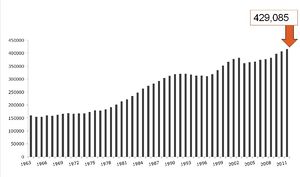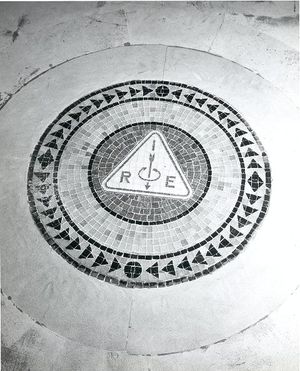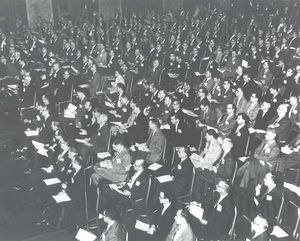IEEE History
IEEE Today
IEEE, an association dedicated to the fostering of technological innovation and excellence for the benefit of humanity, is the world’s largest technical professional society. It is designed to serve professionals involved in all aspects of the electrical, electronic and computing fields and related areas of science and technology that underlie modern civilization.
With more than 425,000 members worldwide (including more than 100,000 student members), IEEE has developed a unique dual complementary regional and technical structure with organizational units based on geography and technical focus. It manages a separate organizational unit (IEEE-USA) which recommends policies and implements programs specifically intended to benefit the members, the profession and the public in the United States.
For more detail on IEEE today, visit IEEE at a Glance on the IEEE homepage. In brief, IEEE is organized into:
- 333 local sections in 10 geographic regions.
- about 2,200 chapters comprised of local members with similar technical interests.
- 39 societies and 7 technical councils that compose 10 technical divisions.
- more than 2,350 student branches at colleges and universities in 80 countries.
- more than 800 student branch chapters
- more than 400 Section Affinity Groups (IEEE-USA Consultants' Network, Graduates of the Last Decade, Women in Engineering, and Life Members.
The governance of IEEE is likewise complex. The voting membership of IEEE elects a new president each year, who serves for three years - first as President-elect, then as President and CEO, and finally as Past President. IEEE presidents also serve on the two top-tier IEEE governing bodies:
- IEEE Board of Directors
- IEEE Assembly
Six subordinate boards of the main Board of Directors govern major areas of IEEE interest. Each has an elected volunteer leader.
- Educational Activities
- IEEE-USA
- Member and Geographic Activities Board (MGA Board)
- Publication Services and Products Board
- Standards
- Technical Activities
In addition, the IEEE Board of Directors over the years has established standing committees to aid it in its governance. There are currently 13 standing committees of the IEEE Board of Directors:
- IEEE Audit Committee
- IEEE Awards Board
- IEEE Employee Benefits & Compensation Committee
- IEEE Ethics and Member Conduct Committee
- IEEE Fellow Committee
- IEEE Finance Committee
- IEEE Governance Committee
- IEEE History Committee
- IEEE Investment Committee
- IEEE New Initiatives Committee
- IEEE Nominations and Appointments Committee
- IEEE Public Visibility Committee
- IEEE Tellers Committee
Also, Presidents of the Societies and Technical Councils serve as part of the governance of the Technical Activities Board.
For a list of previous appointments to committees and boards, see Nominations and Appointments History of Service Manual, 1963 - 2013 and Nominations and Appointments History of Service Manual, 2014 - 2018
Finally, IEEE has approximately 900 employees who support various IEEE activities. The Executive Director is the full-time chief operating officer.
A Brief History of IEEE
Origins
Although it is association of cutting-edge members, IEEE’s roots go back to 1884 when electricity was just beginning to become a major force in society. There was one major established electrical industry, the telegraph, which—beginning in the 1840s—had come to connect the world with a communications system faster than the speed of transportation. A second major area had only barely gotten underway—electric power and light, originating in Thomas Edison’s inventions and his pioneering Pearl Street Station in New York.
Foundation of the AIEE
In the spring of 1884, a small group of individuals in the electrical professions met in New York. They formed a new organization to support professionals in their nascent field and to aid them in their efforts—the American Institute of Electrical Engineers, or AIEE for short. That October the AIEE held its first technical meeting in Philadelphia. Many early leaders, such as founding President Norvin Green of Western Union, came from telegraphy. Others, such as Thomas Edison, came from power, while Alexander Graham Bell represented the newer telephone industry. As electric power spread rapidly across the land—enhanced by innovations such as Nikola Tesla’s AC Induction Motor, long distance AC transmission and large-scale power plants, and commercialized by industries such as Westinghouse and General Electric—the AIEE became increasingly focused on electrical power and its ability to change people’s lives through the unprecedented products and services it could deliver. There was a secondary focus on wired communication, both the telegraph and the telephone. Through technical meetings, publications, and promotion of standards, the AIEE led the growth of the electrical engineering profession, while through local sections and student branches, it brought its benefits to engineers in widespread places.It also gave recognition for outstanding achievement in electrical techonologies through annual awards, begining with the Edison Medal, first presented to Elihu Thomson in 1909. The IEEE logo has a rich history and incorporates elements from the founding organizations and the merger.
Beginning in 1906, the AIEE made its home at the Engineering Societies Building at 29 West 39th St, along with the other Founding Societies.
In 1912, AIEE began its Fellows program. Here is a history of the Fellow Grade together with lists of AIEE, IRE, and IEEE Fellows
Foundation of the IRE
A new industry arose beginning with Guglielmo Marconi’s wireless telegraphy experiments at the turn of the century. What was originally called “wireless” became radio with the electrical amplification possibilities inherent in the vacuum tubes which evolved from John Fleming’s diode and Lee de Forest’s triode. With the new industry came a new society in 1912, the Institute of Radio Engineers (IRE). The IRE was modeled on the AIEE, but was devoted to radio, and then increasingly to electronics. The IRE's headquarters was the magnificent Brokaw Mansion at 1 East 79th St. in New York City. It, too, furthered its profession by linking its members through publications, standards and conferences, and encouraging them to advance their industries by promoting innovation and excellence in the emerging new products and services.
The Societies Converge and Merge
Through the help of leadership from the two societies, and with the applications of its members’ innovations to industry, electricity wove its way—decade by decade—more deeply into every corner of life—television, radar, transistors, computers. Increasingly, the interests of the societies overlapped. Membership in both societies grew, but beginning in the 1940s, the IRE grew faster and in 1957 became the larger group. On 1 January 1963, the AIEE and the IRE merged to form the Institute of Electrical and Electronics Engineers, or IEEE. At its formation, the IEEE had 150,000 members, 140,000 of whom were in the United States. The Headquarters of the newly-formed IEEE was in the United Engineering Center, overlooking the United Nations at 345 East 47th St., New York, New York. The UEC building opened in September 1961, and the founder societies moved there from the West 39th St building, and the IRE moved there from its Brokaw Mansion headquarters to join the AIEE upon the merger in 1963. IEEE remained at the UEC until 1998, when the building was sold to developer Donald Trump, who tore it down to build luxury apartments. IEEE Merger Oral History Collection
IEEE 1963-1984
Over the decades that followed, with IEEE’s continued leadership, the societal roles of the technologies under its aegis continued to spread across the world, and reach into more and more areas of people’s lives. The professional groups and technical boards of the predecessor institutions evolved into IEEE Societies. By the time IEEE celebrated its centennial (from the year AIEE was formed) in 1984, it had 250,000 members, 50,000 of whom were outside the United States. IEEE's expansion caused the IEEE Operations Center to be built in Piscataway, New Jersey.
For more detail on the history of IEEE 1963-1984
One of the ways IEEE preserves the history of its professions is through its Milestones in Electrical Engineering and Computing Program begun in 1983.
Here is a timeline of IEEE from 1963-1984
IEEE from 1984
Since that time, computers evolved from massive mainframes to desktop appliances to portable devices, all part of a global network connected by satellites and then by fiber optics. IEEE’s fields of interest expanded well beyond electrical/electronic engineering and computing into areas such as micro- and nanotechnology, ultrasonics, bioengineering, robotics, electronic materials, and many others. Electronics became ubiquitous—from jet cockpits to industrial robots to medical imaging. As technologies and the industries that developed them increasingly transcended national boundaries, IEEE kept pace, becoming a truly global institution which used the innovations of the practitioners it represented in order to enhance its own excellence in delivering products and services to members, industries, and the public at large.
By the early 21st Century, IEEE served its members and their interests with 38 societies; 130 journals, transactions and magazines; more 300 conferences annually; and 900 active standards.
Publications and educational programs were delivered online, as were member services such as renewal and elections. By 2009, IEEE had 380,000 members in 160 countries, with 44.5 percent outside of the country where it was founded a century and a quarter before. Through its worldwide network of geographical units, publications, web services, and conferences, IEEE remains the world's leading professional association for the advancement of technology.
AIEE, IRE, and IEEE Offices
AIEE, IRE, and IEEE have occupied a number of different office locations during their history:
- Engineering Societies Building, New York City
- Brokaw Mansion, New York City (former IRE Headquarters)
- United Engineering Center, New York City (later sold to, and torn down by, developer Donald Trump to make room for a condominium tower)
- IEEE Piscataway Operations Center, New Jersey
- IEEE Computer Society, Washington, DC
- IEEE-USA Office, Washington, DC
- Vienna Office, Vienna, Austria
- IEEE Computer Society Office, Brussels, Belgium
- Beijing Office, Beijing, China
- Hong Kong Office, China
- Shenzen Office, Shenzen, China
- Bangalore Office, Bangalore, India
- IEEE Computer Society Office, Tokyo, Japan
- IEEE Tokyo Office, Tokyo, Japan
- Singapore Office
Further Reading
For two book-length histories of IEEE and its fields of interest, the full text of The Making of a Profession and Engineers & Electrons are available on the ETHW. The Making of a Profession in particular covers the history of AIEE, IRE, and IEEE.
An Overview of 125 Years of IEEE History (ppt) - A slideshow presentation of the history of IEEE, by Sheldon Hochheiser, 2009.
History of IEEE Since 1984, by IEEE History Center Staff, 2020






